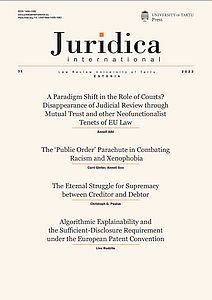The European Court of Human Rights and the Principle of Foreseeability (Lex Certa and Stricta): How to Determine Whether an Offence Is Clearly Defined in Criminal Law
DOI:
https://doi.org/10.12697/JI.2022.31.07Keywords:
European Court of Human Rights, principle of foreseeability, nullum crimen sine lege certa and stricta, an offence’s wording and its interpretationAbstract
The European Court of Human Rights has applied the principle of foreseeability (lex certa and lex stricta) on many occasions to determine whether a person could have foreseen at the time of the act that the act matches the description of an offence in a criminal-law provision and is therefore punishable. This raises a question that has been decisive for the outcome of many cases: how can one ascertain whether the wording for an offence is sufficiently clear? The article examines the guidelines set forth by the European Court of Human Rights for the use of the principle of foreseeability and whether it is possible to speak of a standard on the basis of the case law for the wording for an offence and the associated interpretation, in aims of ensuring compliance with the principle. Also discussed are the problems that have arisen in connection with the issue and what questions have yet to be answered. Proceeding from the case law, the author offers conclusions as to what could form a basis for determining whether a person should have foreseen liability and punishment incurred via commission of the act in question.Downloads
Download data is not yet available.
Downloads
Published
2022-10-25
How to Cite
Truu, M. (2022). The European Court of Human Rights and the Principle of Foreseeability (Lex Certa and Stricta): How to Determine Whether an Offence Is Clearly Defined in Criminal Law. Juridica International, 31, 98–110. https://doi.org/10.12697/JI.2022.31.07
Issue
Section
Articles


